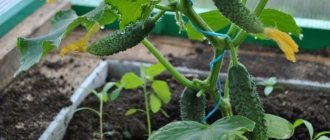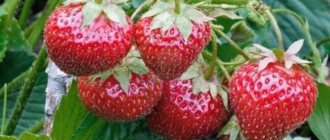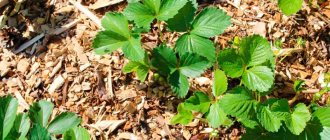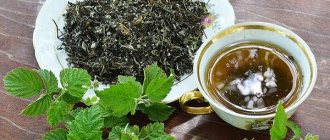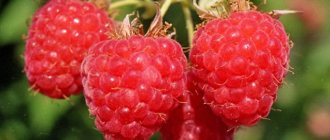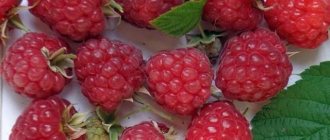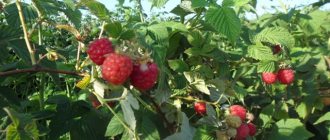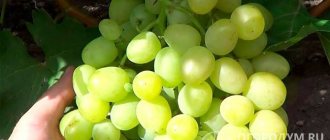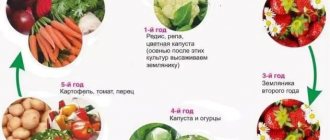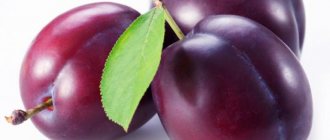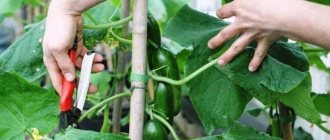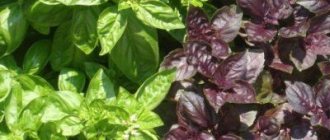Raspberry tree Tarusa - the most productive variety
Similar articles Since
A plant planted in autumn does not have time to ripen and dies from frost. You should not expect a large harvest in the year of planting; the young bush will lag behind in development from those previously planted.
Raspberry tree - what is it?
Advertising.
Noted
Among supporters of the use of double pruning, which is the second time when pruning raspberry plantations and bushes, is considered the main agrotechnical technique. With this pruning, we force the dormant and axillary buds of raspberry plants to grow and thereby bring the raspberry bush to a higher stage of fruiting, adding another 10-20 highly fruitful raspberry vines to the main shoots we left behind.
Why choose Tarusa raspberry tree
Features of agricultural practices
Timely pruning of raspberries directly affects the condition of the plants and the quality of fruiting. In addition to ensuring good development, higher yields and improved taste of berries, such agrotechnical measures prevent the occurrence of diseases and reduce the number of pests. At the same time, it is important to know how to properly prune raspberries in order to help and not harm the plantings.
Related article:
An easy way to grow remontant raspberries
In almost all species of this crop, flower buds appear only on shoots of the second year of life. At its beginning (in spring), such branches are shortened. This technique ensures intensive branching and the appearance of large berries, and the branches themselves gain stability. To determine how tall the raspberry should be after pruning, you need to focus on the location of the top bud. The approximate length of the cut shoot is 50–100 cm.
After the fruiting period ends, the shoots become dry and barren, and new ones grow nearby from the root of the bush. This process of natural renewal cannot proceed normally without human intervention. If you do not cut off the old branches, the young shoots will not be able to grow stronger before the onset of cold weather and will simply freeze over the winter.
In general, the set of measures for pruning raspberry plantations includes the following actions:
- cutting out old, weak, damaged and fruit-bearing shoots;
- shortening of healthy processes in the first year of life;
- removal of root shoots.
In addition, it is mandatory to prune raspberries after planting so that the rapidly growing green mass does not take away the life-giving juices necessary for rooting of plants. Before pruning raspberries, they are first planted and then shortened to 30 cm from ground level.
Related article:
Raspberries: secrets of care
Tree raspberry
Currently, there are many varieties of this shrub, which allows you to obtain fresh produce for a long time by selecting several varieties with different fruiting periods.
From experience
harvest volume
Miracle tree
Actinidia plant: description and photo
Raspberry bushes can be rejuvenated. To do this, carefully dig out the center of the old bush with a shovel, removing the old rhizome. Replacement shoots from the remaining roots in the soil grow strongly, are less damaged by diseases and pests, and bear fruit well. This method is used to extend the life of a plantation in one place to 15-30 years.
Fragrant raspberry or raspberry
Ordinary raspberries most often reproduce by root suckers. But since the raspberry tree almost does not form them, root or stem cuttings are taken for propagation. You can use seed propagation, but this process is too labor-intensive and therefore very rarely used.
But while bush raspberries are known to everyone, tree raspberries are less popular; many have not even heard of them. But despite its unpopularity, tree raspberries have the same taste and, moreover, are even more picky to care for. It can also grow anywhere, under a fence or house, and does not require special care.
During the growing season, the plantings must be watered abundantly, but there is also no need to flood them so that the roots do not rot.
Top dressing
The raspberry tree includes standard varieties of this berry, varieties that do not require support when growing. They hold up well; the branches of the bush can bend under the weight of the berries, but they will not fall, since they are rigid with shortened internodes. Raspberry tree is not the name of the variety, but the growing method.
If in winter it is possible for temperatures to drop below -30 C, then after the end of fruiting the stems of the bush should be bent to the soil; if this is not done in time, the shoots will become woody and as a result will become brittle.
The raspberry tree includes standard varieties of this berry, varieties that do not require support when growing. They hold up well; the branches of the bush can bend under the weight of the berries, but they will not fall, since they are rigid with shortened internodes. Raspberry tree is not the name of the variety, but the growing method.
Landing
Western gardening practitioners have a solution to this raspberry problem. The solution was found in “Separate cultivation of raspberries.”
berries by 2 times, due to the new shoots that have formed, which by the end of summer - beginning of autumn they will multiply and give a good and large harvest of ripe berries on the grown branches of the bushes.
Reproduction
Grapes are a useful plant
Watering
Watch the spring pruning video to better understand the technique of this method of shaping shrubs:
Trimming
Black raspberry
Tree raspberries are moisture-loving plants and require frequent watering. To reduce the frequency of watering, it is recommended to mulch the rows.
Wintering
Raspberry tree - this is how tree raspberries are often called. It received this name because of its powerful shoots. When you look at a plot with tree-like raspberries, it seems that it is planted with trees.
Pests and diseases
If in winter it is possible for temperatures to drop below -30 C, then after the end of fruiting the stems of the bush should be bent to the soil; if this is not done in time, the shoots will become woody and as a result will become brittle.
MegaOgorod.com
Harvesting
Do not pick raspberries immediately after rain or when there is dew to avoid rapid spoilage. Raspberries with a stalk are stored longer and are easier to transport. Harvest every two days as ripe berries appear (usually mid-July); avoid over-spilling, as this will cause the fruits to wrinkle.
As you can see, a raspberry tree can not only produce a rich harvest of delicious berries (with proper care), but also decorate your areas with its unusual appearance. Don't forget to repost this interesting article for your friends, and also subscribe to new publications on my blog.
How to prune raspberries in spring
With this method of growing shrubs, fruit-bearing branches are cut out and the tops of young shoots are pinched, which leads to the awakening of side shoots.
By leaving only one replacement shoot, you can get an upright, tree-like, non-lodging bush. Raspberry plantings Mulching the soil is important:
Care and rules for pruning raspberries
With this method of growing shrubs, fruit-bearing branches are cut out and the tops of young shoots are pinched, which leads to the awakening of side shoots. By leaving only one replacement shoot, you can get an erect, tree-like, non-lodging bush.
| I cut out old and diseased raspberries closer to autumn, and in the spring I trim the tops. But they told me that this is wrong. | |
| With such pruning | |
| Prune the tops of the young vine when it reaches 1-1.5 m. On very tall varieties of berries, pruning is done at a length of 70-80cm. It is important to know that it is pruning and not pinching 10-20cm of the tops of raspberry shoots that gives the desired result. | |
| There is a new, progressive method of pruning raspberries - the so-called double pruning. Its essence is to carry out the first pruning of young shoots at the end of May - the first ten days of June, when their height just begins to reach 1 m. | |
| Remontant raspberry | |
| Tree raspberries require pruning three times a year. It is pruned for the first time in May. At this time, excess, dry and damaged branches should be removed, leaving 7 shoots on each bush. | |
| Such raspberries are characterized not only by wonderful taste, but also by high yield. In addition, tree raspberry is an ornamental plant with velvety leaves, which is very beautiful during flowering and has large fruits. | |
| Raspberry plantings must be weeded, loosened and mulched. Mulching the soil is important: | |
| The number of lateral shoots of standard raspberry varieties reaches 10 pcs. By autumn they are about 50 cm long. After the leaves fall, the bush looks like a small tree, which gives rise to its name. With optimal care, such a bush will produce a much larger harvest than a plant that was not formed in this way. Increasingly, summer residents are growing raspberry trees on their plots, reviews of which are usually positive. | |
| in summer it protects the soil from overheating, its temperature remains uniform; | |
| The number of lateral shoots of standard raspberry varieties reaches 10 pcs. By autumn they are about 50 cm long. After the leaves fall, the bush looks like a small tree, which gives rise to its name. With optimal care, such a bush will produce a much larger harvest than a plant that was not formed in this way. Increasingly, summer residents are growing raspberry trees on their plots, reviews of which are usually positive. | |
In fact, it is recommended to cut out fruit-bearing shoots of raspberries immediately after harvesting. At the same time, it is advisable to carry out preliminary normalization of annual shoots, removing weak and broken ones, so that the berry grower does not waste nutrients and moisture on them.
fruiting process
When pruning
Pinch the top of the shoot. The growth of the shoot in height stops for two weeks or more, and lateral shoots develop from the axils of the leaves of the pinched shoot. However, when pruning raspberries twice, you must keep in mind that the plantation in this case becomes very thick, and therefore it is necessary to increase the distance between plants to 30 cm.
Raspberry tree
Repeated pruning is carried out in June: the tops of the bushes are cut off. In July, the side shoots are pruned so that the bush can direct all its strength to the formation of flower buds, which will increase the yield.
Double pruning of raspberries - a new, progressive method
The shoots of tree raspberry have a felt and waxy coating and are completely devoid of thorns. Its internodes are shortened.
in summer it protects the soil from overheating, its temperature remains uniform;
The Tarusa raspberry tree is recognized as one of the most promising modern varieties for personal farming; it has:
Mulch prevents the rapid evaporation of moisture,
Raspberry harvest
The Tarusa raspberry tree is recognized as one of the most promising modern varieties for personal farming; it has:
You should not keep diseased stems until autumn, because they are a source of infection. Particular attention should be paid to removing unnecessary growth, which many varieties are generous with, because it sometimes depletes the raspberry tree more than weeds.
The berries last a sufficient period of time, 2-3 months, and simple raspberry varieties turn into remontant varieties, inheriting and adopting their properties.
the upper part of the raspberry shoots, dormant buds awaken and in the process of further growth of the plant (fruit-bearing raspberry vine), by autumn 3-6 shoots 50 cm long or more will appear from them. This takes away the raspberry’s growth potential and deteriorates the quality of the harvest (the berries become smaller), and they lose their growth and berry ability.
| The second pruning must be done in the spring, shortening the side shoots of the previous year that grew after the first pruning of the main shoot. | ||
| Yellow raspberry varieties | ||
| One nuance you need to know for those who have tree raspberries. Tree raspberries, being quite frost-resistant, may not withstand 30-degree frost. Therefore, it is better to bend it down and bury it in the fall. This work should be done in early autumn. At this time, the branches show flexibility and do not break, as in late autumn. | ||
| Tree raspberries do not need support, but it is still advisable to grow them on a trellis. She reaches two meters in height. |
udec.ru
Standard raspberries and their cultivation
The name “raspberry tree” is often mentioned in advertising when talking about standard raspberries. The word "trunk" means the trunk of a tree from the roots to the top. Standard raspberries really resemble a tree in appearance, especially since the bushes can reach two meters in height.
Raspberry tree
Some inexperienced gardeners seriously believe that raspberries can grow in the form of a tree with one trunk and do not sprout. In fact, standard raspberries are the same bush as all other types of this plant. However, having very thick shoots, standard raspberries fully deserve their nickname.
Features of agricultural technology for standard raspberries
Fans of remontant varieties, such as Indian Summer or September, should get acquainted with the raspberry tree, since these raspberry varieties bear fruit in early autumn, that is, at the end of the growing season. Annual stems growing in April - August produce very few flower stalks. Standard culture makes it possible to increase their number. The method is quite simple and involves pinching the top, due to which the plant actively forms side shoots.
In this way, the same “raspberry tree” is obtained, having a trunk and 6-7 tops. As their number increases, more flower stalks grow, which means the yield of the entire bush increases.
Standard raspberries need sufficient living space for good growth; bushes should be placed at reasonable intervals. To avoid frost damage to the berries in October and November, you need to achieve as much ovary mass as possible before the beginning of September. To do this, the plant requires proper care from the beginning of spring in order to start pinching off the tops as early as possible. The advantages of standard raspberries include the ability of the trunk not to fall under the weight of the ripening berry crop.
Varieties of standard raspberries
The standard raspberry varieties Tarusa, Skazka, Krepysh and Galaktika do not need to be attached to a trellis. They grow up to 200 cm, with thick shoots, like the handle of a rake, they are elastic and quite rigid, the shoots almost never get thinner upward. By the second year, the bushes are thoroughly covered with fruit branches with densely growing berries, due to shortened internodes.
Among the varieties mentioned above, Tarusa stands out for its qualities. During the growth process, this standard raspberry practically does not form useless shoots, and the bush of the plant consists of powerful, erect shoots. The flowering of this variety is extremely beautiful, and the berries have an excellent taste, are bright red in color and large in size, with the weight of the berries ranging from 4 to 12 grams.
This prestigious variety of standard raspberries has the highest yield among other varieties. The good thing about growing the Tarusa variety is that it does not require pruning. This way, gardeners won’t have to worry about raspberry shoots spreading throughout the area.
An important feature of some varieties of standard raspberries is that they produce crops throughout the summer, until the onset of the first autumn frosts.
Care and fertilizers
Before planting raspberries, it is necessary to fill the soil well with organic and mineral fertilizers. The plant definitely needs regular watering, since without it the raspberry harvest will be in jeopardy. But it is worth remembering that the roots can rot from excess moisture, and the plant will die in this case. Therefore, care should be taken regarding watering.
Gardeners should know that, like regular raspberries, the standard variety produces replacement shoots. If you cut them out and leave only one, then such a bush will resemble a tree that will not bend even when the branches are fully loaded with a heavy harvest. If replacement shoots are not removed, then during fruiting they will bend under the weight of large berries, but due to the thickness and strength of the shoots, the berries will not fall to the ground. After harvesting, the shoots are cut out like regular raspberries.
Almost all varieties have high winter hardiness and are quite unpretentious in care. If you provide quality care, standard raspberries significantly increase productivity.
However, there is a possibility of obtaining a low berry yield if the bush grows strongly, shoots are left behind, or basic agrotechnical rules are not observed. If the gardener has no intention of properly caring for such raspberries, then it is better not to plant them, but to grow varieties with a high level of adaptation.
How to buy seedlings
Today, there are often cases when, under the guise of varietal raspberries, dishonest sellers sell wild shoots dug up from abandoned plots, which are not capable of producing any harvest. Gardeners who want to purchase raspberry seedlings should be careful when purchasing and follow simple rules.
- It is best to purchase seedlings from specialized nurseries;
- Sellers at markets must have a badge indicating personal data and documents for seedlings;
- You should not purchase seedlings outside of retail outlets, for example, on roadsides.
The above will allow you to avoid deception from dishonest sellers, and real standard raspberries will delight garden owners with an abundant harvest of large and tasty berries.
OgorodSadovod.com
First raspberry pruning.
Mulch prevents the rapid evaporation of moisture,
High productivity; with proper pruning, it can produce two harvests per season. The berries are very large (up to 14-16 g), beautiful elongated shape with a bright red color and shiny. They are easy to remove.
slows down the growth of weeds and increases soil fertility;
High productivity; with proper pruning, it can produce two harvests per season. The berries are very large (up to 14-16 g), beautiful elongated shape with a bright red color and shiny. They are easy to remove.
It is advisable to pull it out or cut it at depth with a shovel immediately after its appearance. It is useless to cut at the surface of the soil; this promotes its proliferation even more.
Second raspberry pruning.
There are also
For deadlines
As you can see in the photo, pruning raspberries using this method is done on a well-developed bud. The double pruning method helps to obtain a higher quality and higher yield.
Pruning raspberries in spring
A distinctive feature of this raspberry variety is that it is quite resistant to pests and diseases, but even if trouble occurs, it does not affect fertility in any way. Fruit The berries of the raspberry tree ripen in early July. They have an elongated shape and reach 16 grams of weight. From one bush you can collect 3-4 kilograms of berries, which are distinguished by excellent density and can easily be transported. They can be stored in the refrigerator for a week without losing their taste. The berries have a pleasant “raspberry” aroma, juicy melting pulp and a few small seeds. They are suitable for fresh consumption and for preservation. From these berries you can make jam, jam and pastille. They are also suitable for drying.
slows down the growth of weeds and increases soil fertility;
The berries have excellent taste and aroma, are dense and withstand transportation well. The berries of the Tarusa raspberry tree can be consumed not only fresh, but also for all types of processing, because they have few seeds and they are very small. In winter,
The berries have excellent taste and aroma, are dense and withstand transportation well. The berries of the Tarusa raspberry tree can be consumed not only fresh, but also for all types of processing, because they have few seeds and they are very small.
Disadvantages of double pruning raspberries.
Early in the spring, when it becomes clear which shoots have overwintered well, you should choose the best ones, leaving 4-5 of them per bush if the raspberries are planted using the bush method, or 12-15 per 1 m of row when grown in rows. reverse
pruning raspberry bushes: third decade of May - first week of June. Late pruning of plants can affect the physiological growth of shoots and will have a bad effect on the yielding ability of raspberries.
With the onset of June, early varieties of disposable raspberries ripen. How to choose the right time to pick berries? The fact is that the berry cannot be kept on the bushes; if it is overripe, it loses its presentation and taste, and besides, it does not allow the next berries to ripen, because raspberries are a crop for repeated harvesting.
Raspberry care
Pruning raspberries in the spring is a necessary procedure aimed at increasing future yields and making the bushes decorative. You can perform pruning in the usual way, but there is another, according to gardeners, a more promising method called double pruning.
Berry ripening is consistent. Due to their density, the berries can last on the bush for 3-4 days. Therefore, the harvest is usually harvested 2 times a week.
in winter it serves as a shelter for the roots and protects them from freezing.
The root system resembles the root of a tree and does not produce much growth, that is, it does not “spread” throughout the area. When raspberries are grown for berries, and not for planting material, this quality is a big plus.
Timing for spring pruning
Spring pruning of raspberries is carried out before the buds open and the juices begin to flow. The temperature should be positive during the day and there should be no soil frosts at night. In different regions, the timing varies depending on weather conditions.
The average values are:
- southern regions - early April;
- middle zone - early May;
- The Urals and Siberia - the second ten days of May.
Some gardeners prune raspberries after the buds open, because then it is easy to see which shoots are alive and which are dead. However, this is fraught with infection of the sections with fungal infections.
How to prune common raspberries?
In addition, the raspberry tree must be fed, otherwise it will not be able to develop to its characteristic size, and it will not be possible without fighting diseases and pests. Without carrying out all the necessary agrotechnical measures, it is impossible to get such a raspberry Tarusa tree as in the photo below.
The root system resembles the root of a tree and does not produce much growth, that is, it does not “spread” throughout the area. When raspberries are grown for berries, and not for planting material, this quality is a big plus.
You need to get rid of all the unnecessary ones. At the same time, you need to trim the dried tops of the shoots left for fruiting. They should be cut to a well-developed bud, but it is advisable to try not to shorten them excessively (more than 20-25 cm).
double pruning, the disadvantages of this method include: fouling and strong thickening of raspberry bushes. As a result, it turns out that the shoots are unventilated and strongly shade each other, which causes pests and diseases, and a high probability of losing crops and plants.
Pruning dates
The best time to harvest raspberries is early morning or evening, when there is no dew. For containers, it is best to use special baskets with a capacity of 0.5-1 kg or plastic containers with the same capacity. Large containers should not be used so that the berries do not squash under their own weight.
Raspberry pests
Its essence lies in the fact that the branches are shortened twice during one growing season. You will learn below how to prune using both methods.
In order for the tree to bear fruit well, it is necessary to provide feeding with peat, humus or manure. Fertilizing doubles the yield of a raspberry tree.
In addition, the raspberry tree must be fed, otherwise it will not be able to develop to its characteristic size, and it will not be possible without fighting diseases and pests. Without carrying out all the necessary agrotechnical measures, it is impossible to get such a raspberry Tarusa tree as in the photo below.
frukta.ru
Raspberry tree Tarusa - the most productive variety
It is possible to grow without supports or stakes, since the plant has tough, thick and strong shoots that do not have thorns. The formation of
The first time the shoots are pinched after planting in May, when the shoots reach 60 cm. The stems are shortened by 5-10 cm. After pinching, lateral branches grow in the leaf axils, which are pinched a second time in the spring of next year. After the danger of frost has disappeared, the branches need to be cut back by 15 cm. Later, many fruitful branches will appear on the stem, from which a rich harvest can be harvested in early autumn.
Raspberry tree - what is it?
It is possible to grow without supports or stakes, since the plant has tough, thick and strong shoots that do not have thorns.
Significant shortening of raspberry stems will lead to a decrease in yield, although the size of the berries and their number on the branches may increase. If the stem is not cut at all, many of the berries will be small.
What to do
Why choose Tarusa raspberry tree
were determined in the spring of the next year, when after the autumn-winter period the raspberry bushes fully opened their buds and blossomed. It is necessary to trim about 10-15 cm from the upper part of the shoots, those that we cut off in the fall, and from which new young raspberry branches began to develop (we cut them off).
- The sequence of collection is also of great importance. Collection should begin from the lower tier and gradually move to the upper branches. In this case, the berries located on the lower tier and inside the bush will not be damaged or fall off.
- Immediately after harvesting, fruit-bearing shoots are cut to the soil level, without leaving stumps, and damaged and weak young shoots up to 50 cm high are also removed. According to the rules for pruning raspberries, the strongest and most mature shoots are left at a distance of 10-15 cm from each other or in a total of 10-15pcs. per 1 linear meter of strip.
- Care and pruning of regular varieties of raspberries are the simplest procedures in comparison with the care and pruning of other berry bushes. This is determined by the biological characteristics of the plant, more precisely, by the two-year development cycle of its stems.
- When growing tree raspberries, you can use an effective method that helps retain moisture and supply the roots with nutrients. To do this, manure is spread over the entire area with raspberries in a layer of 15-20 centimeters. Instead of manure, you can use urea or saltpeter. But it is added per 1 linear meter of approximately 100 grams.
- The formation of a raspberry tree is carried out using the double pruning method. The first time the shoots are pinched after planting in May, when the shoots reach 60 cm. The stems are shortened by 5-10 cm. After pinching, lateral branches grow in the leaf axils, which are pinched a second time in the spring of next year. After the danger of frost has disappeared, the branches need to be cut back by 15 cm. Later, many fruitful branches will appear on the stem, from which a rich harvest can be harvested in early autumn.
Other features of the variety
High winter hardiness and relatively good resistance to many diseases.
Growing and caring for the Tarusa raspberry tree
Berries in remontant raspberry varieties are also formed on the growth of the current season. The method of pruning shoots depends on how many crops it is desirable to harvest per season. When pinched twice, the plants will produce one harvest. To obtain two harvests, pruning is done in the fall; in the spring, only frozen or dried branches are cut out. Helga-Oli's find
High winter hardiness and relatively good resistance to many diseases.
There is another way to trim raspberries - according to the Sobolev method. This is a double cut. It consists in the fact that the top of young annual shoots of tall raspberries is pinched at the end of July by 10 centimeters. As a result, lateral branches appear from the axils of the upper leaves. In the spring of next year, these branches will need to be shortened by 5-15 cm, and the top of the central stem will no longer be cut off.
in such a difficult situation? Everything is very simple, you need to increase the distance between the rows of raspberries to 2 meters, and in the row between the bushes to 1-1.5 m, and leave up to 10 shoots per bush.
There is an opinion
- To free both hands for collecting, the basket is attached to the belt or neck. It is also advised to use an ordinary kitchen apron with two or three pockets, in which glass jars with a capacity of 0.7 liters are placed and berries are collected from the bush in them, and then carefully poured into baskets. Rotten and damaged berries must be stored separately, then they should be buried in the ground. Raspberries can be harvested without the stalk, but only in this case they can be immediately consumed or processed. It should be remembered that the collected berries begin to intensively release juice after two hours of storage. Therefore, it is better to collect berries with stalks, so they are not damaged. If the berries will be stored for some time, it is better to pick them off along with the “tails.”
- In the fall, later, raspberries are tied into bunches to avoid breakage during wet snow.
- Subcategories
- In the fall, it is advisable to fertilize the soil under raspberries with mineral fertilizers. These fertilizers are scattered over the surface of the soil and incorporated using a rake.
Berries in remontant raspberry varieties are also formed on the growth of the current season. The method of pruning shoots depends on how many crops it is desirable to harvest per season. When pinched twice, the plants will produce one harvest. To obtain two harvests, pruning is done in the fall; in the spring, only frozen or dried branches are cut out.
Advantages of remontant raspberries over conventional varieties
The main varieties of this new, but increasingly gaining popularity, raspberries: Penguin, Izobilnaya Kazakova, Zeus, Augustovskoye Miracle, Indian Summer, Polka, Firebird, Bryansk Miracle, as well as varieties of yellow and black raspberries, for example, Ugolek, Yellow Giant, Slastena and others.
"One-year" technology
There is one peculiarity here: the berries ripen both on last year’s shoots and on new ones. Some produce crops in the summer, others in the fall. It is important to leave new ones to harvest in the fall, when there are no more berries. After all, the summer harvest delays the ripening of the autumn harvest, so it is wiser to refuse the first (summer) one.
With this option, remontant raspberry varieties are grown as annual bushes:
- At the beginning of summer, annual shoots grow intensively.
- Then twigs appear, which will later bear fruits.
- The next stage is flowering.
- Depending on the variety, you can harvest in the second half of August or early September.
- In late autumn, all shoots are cut off at the root, and the raspberries overwinter without any branches remaining on the surface of the ground.
There are several pruning methods, which allows you to choose the most convenient for each gardener. Unlike ordinary raspberries, here you can independently regulate the amount of harvest and the time of harvest using pruning.
With the “one-year” technology, a number of advantages appear that simplify the care of raspberries, on the one hand, and on the other hand, fruiting increases, and the raspberry tree is maintained in a neat condition.
- Since everything is cut down at the roots in the fall, the problem of wintering disappears - there is nothing to freeze.
- Maintenance is greatly simplified, which saves time and effort. There is no need to then clean the raspberry tree from damaged, dry and broken branches. There is also no need to bend the bushes down for the winter and add snow under them. By themselves, these varieties have fairly strong branches up to 2 meters in height, which do not need either gartering or bending.
- The problem with pests (raspberry beetle and raspberry-strawberry weevil), which can destroy 50% of the crop, is being solved.
The fact is that with this method the phase of pest reproduction and the phase of growth and fruiting of raspberries do not coincide. And when pruning all shoots in the fall, pests are also destroyed, which can survive the winter in ordinary raspberries if this process is not monitored.
Therefore, this pruning method is recommended, and regular raspberry varieties can be grown for the summer harvest. This way you will get two full harvests.
The Dutch method of pruning remontant varieties
There is also a method that allows Dutch gardeners to get up to 30 kg of berries from one bush. The essence of this pruning is as follows:
- From the main 8 - 10 stems there are 4 - 5 shoots. The first step is to lightly pinch the middle to allow young shoots to grow.
- Shorten each of these 4 - 5 shoots by about 10 cm so that new bushes begin to form.
- Next year, cut off the middle and leave the new bushes so that the raspberries are not too dense.
As a result, instead of 10 bushes, we get about 100, and each one produces a good harvest. The good thing about this method is that you can quickly make a large raspberry patch without planting new bushes.
If you like one of the varieties of remontant raspberries more than others, then this method is ideal for propagation.
Sobolev pruning method
Also a popular type of pruning, similar to Dutch, with minor differences. Also called the double cutting method. Productivity increases significantly
- In June, when the height of the bush reaches more than one meter, pinch it for the first time.
- New shoots begin to grow in the axils of the leaves and buds. By the end of summer there will already be 4 - 6 shoots 50 - 70 cm high.
- Next year in spring, the side shoots are shortened by 10 - 15 cm.
To visually familiarize yourself and better understand the methods and reasons for pruning, I recommend the following video:
